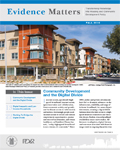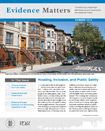| FALL 2016 |

FALL 2016 |
-
-
“Broadband Internet Access and the Digital Divide: Federal Assistance Programs” (2013), by Lennard G. Kruger and Angele A. Gilroy, reviews federal initiatives aimed at expanding broadband access. www.fas.org/sgp/crs/misc/RL30719.pdf.
-
The Pew Research Center’s “Internet, Science & Tech” website contains publications, datasets, and other resources on Internet use and the digital divide, including those on digital readiness and the homework gap. www.pewinternet.org/.
-
“Digital Human Capital: Developing a Framework for Understanding the Economic Impact of Digital Exclusion in Low-Income Communities” (2013), by Amy Bach, Gwen Shaffer, and Todd Wolfson, calls for digital inclusion programs to go beyond connectivity and foster civic engagement and social change. www.jstor.org/stable/pdf/10.5325/jinfopoli.3.2013.0247.pdf.
-
-
“The Digital Divide and Patient Portals: Internet Access Explained Differences in Patient Portal Use for
Secure Messaging by Age, Race, and Income” (2016), by Graetz et al., examines the association between patients’ use of online
healthcare messaging portals and computer and Internet access. journals.lww.com/lww-medicalcare/toc/2016/08000.
-
-
Back to top
|
| SUMMER 2016 |

SUMMER 2016 |
-
-
“Vulnerable Youth: Employment and Job Training Programs” (2015), by Adrienne L. Fernandes-Alcantara, reviews federal youth employment initiatives, including some aimed specifically at youth offenders. www.fas.org/sgp/crs/misc/R40929.pdf.
-
-
“Building Our Way Out of Crime: The Providence, Rhode Island, Case Study” (2009), by Bill Geller and Lisa Belsky, explores community developer-police collaboration in the Olneyville neighborhood of Providence, Rhode Island. The study describes several positive public safety outcomes resulting from a sustained and concerted collaborative effort to use community development to ameliorate crime hot spots. www.olneyville.org/Geller-Belsky-case-study.pdf.
-
-
The New Jim Crow: Mass Incarceration in the Age of Colorblindness (2010), by Michelle Alexander, investigates the racial disparities in incarceration and criminal justice and their consequences. newjimcrow.com/.
-
“Halve the Gap by 2030: Youth Disconnection in America’s Cities” (2013), by Kristen Lewis and Sarah Burd-Sharps, provides data on youth disconnection and advances recommendations for reconnecting youth, preventing disconnection, and setting measurable targets for reducing disconnection. ssrc-static.s3.amazonaws.com/moa/MOA-Halve-the-Gap-ALL-10.25.13.pdf.
-
-
Back to top
|
| SPRING 2016 |

SPRING 2016 |
-
The Urban Institute’s Housing Finance Policy Center offers "Housing Finance At A Glance," a monthly chartbook of relevant housing finance statistics, a Housing Credit Availability Index, and ongoing analysis of housing finance issues. www.urban.org/policy-centers/housing-finance-policy-center.
-
The American Mortgage System: Crisis and Reform (2011), edited by Susan M. Wachter and Marvin M. Smith, contains a series of essays addressing the causes and implications of the housing crisis as well as recommendations for reforming the mortgage system and its core institutions. www.upenn.edu/pennpress/book/14884.html.
-
"An Overview of the Housing Finance System in the United States" (2013), by Sean M. Hoskins, Katie Jones, and N. Eric Weiss, introduces readers to the workings of the primary and secondary mortgage markets. www.fas.org/sgp/crs/misc/R42995.pdf.
-
-
-
"Globalization of Finance and the Future of Home Mortgage Finance" (2015), by Kathe Newman, discusses how changes in the modern banking system since the middle of the 20th century have created new problems for mortgage credit supply. www.tandfonline.com/doi/pdf/10.1080/10511482.2015.1042209.
-
Homeownership Built to Last: Balancing Access, Affordability, and Risk After the Housing Crisis (2014), edited by Eric S. Belsky, Christopher E. Herbert, and Jennifer H. Molinsky, addresses the central tension of post-crisis housing finance: the twin policy goals of expanding credit access and limiting risk to taxpayers, financial institutions, and homeowners. www.brookings.edu/research/books/2014/homeownership-built-to-last.
-
-
"Challenges and Changes in Community-Based Lending for Homeownership" (2011), by Abigail Pound, discusses strategies used by community-based organizations, such as certified community development financial institutions, community development corporations, and nonprofit homeownership centers, to expand mortgage lending to low- and moderate-income households. www.jchs.harvard.edu/sites/jchs.harvard.edu/files/w11-2_pound.pdf.
Back to top
|
| WINTER 2016 |

WINTER 2016 |
-
-
-
"Leveraging the Social Determinants of Health: What Works?" (2015), by Lauren A. Taylor, Caitlin E. Coyle, Chima Ndumele, Erika Rogan, Maureen Canavan, Leslie Curry, and Elizabeth H. Bradley, evaluates and summarizes the evidence underlying interventions that address social determinants of health and focuses on innovative models in Massachusetts that improve health and reduce costs. bluecrossfoundation.org/sites/default/files/download/publication/Social_Equity_Report_Final.pdf.
-
"Reconnecting Health and Housing: Philanthropy’s New Opportunity" (2015), by David D. Fukuzawa and Fred Karnas, explores how philanthropy can play a vital role in connecting the housing and health sectors by building an evidence basis, fostering discourse and policy change, and promoting innovation. online.liebertpub.com/doi/pdfplus/10.1089/env.2015.0006.
-
-
"Housing and Health Care: A Toolkit for Building Partnerships" (2014), by Leading Age, provides a variety of practical resources related to housing and health care partnerships, including guides on how to identify partners and structure relationships, insights from healthcare practitioners, and a return-on-investment calculator. leadingage.org/housinghealth/.
-
-
The "Dimensions of Quality" toolkit, by the Corporation for Supportive Housing, provides resources on implementing permanent supportive housing programs for housing developers, government officials, tenants, and healthcare organizations. www.csh.org/quality.
-
"Medicaid and Permanent Supportive Housing for Chronically Homeless Individuals: Emerging Practices From the Field" (2014), from the U.S. Department of Health and Human Services, explains how federal government resources have expanded permanent supportive housing and innovations in healthcare that will affect Medicaid and housing programs. aspe.hhs.gov/sites/default/files/pdf/77116/EmergPrac.pdf.
"The Payoff of Pay-for-Success" (2015), by V. Kasturi Rangan and Lisa A. Chase, argues that adapting pay-for-success contracts outside a narrow band of social policy will be difficult and that philanthropies, not private investors, will remain the major source of funding. ssir.org/up_for_debate/article/the_payoff_of_pay_for_success.
-
Back to top
|

